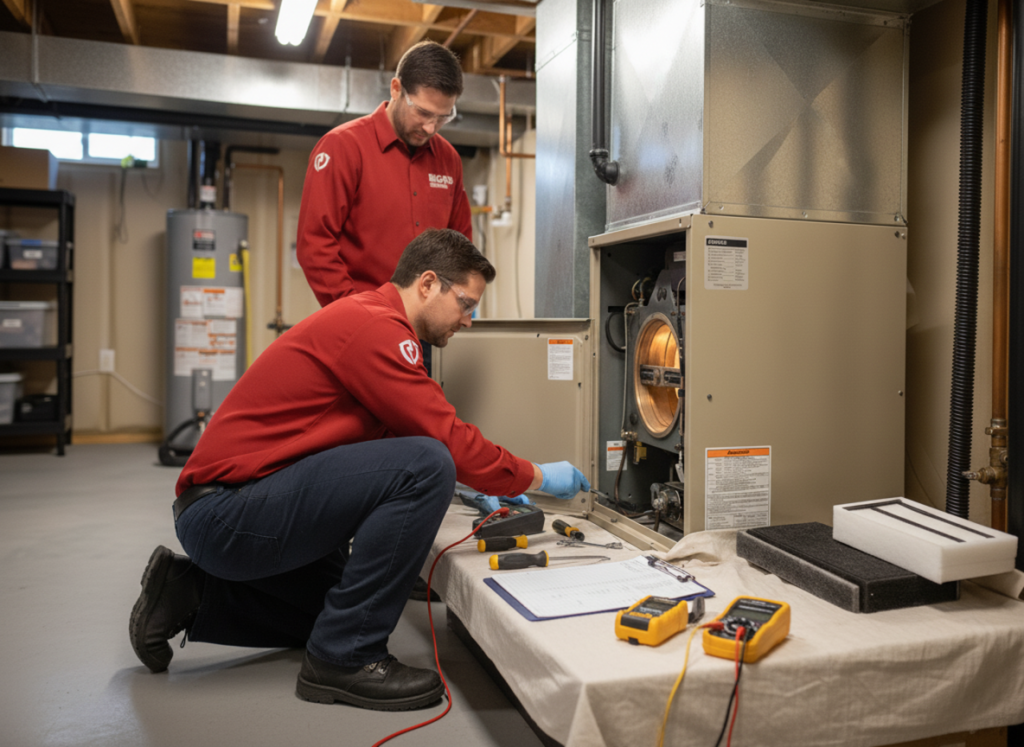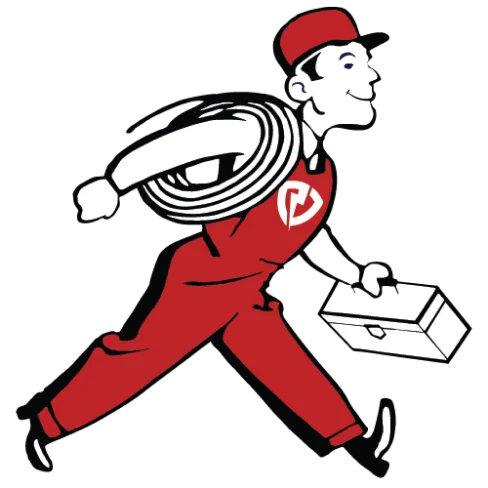Your furnace is one of the hardest-working systems in your home, quietly keeping everyone comfortable throughout the cold months. But like any hardworking machine, it needs maintenance and attention to perform at its best.
The good news? By following a straightforward seasonal maintenance routine, you can help your furnace last 15 to 20 years while keeping your energy bills under control and avoiding those dreaded emergency repair calls.
The Importance Of A Furnace Service
When you skip regular check-ups, small problems have a way of turning into big, expensive ones. A well-maintained furnace runs more efficiently, which means lower heating bills and fewer midnight emergency service calls when temperatures drop.
Beyond the financial benefits, proper furnace maintenance protects your family’s safety. Gas furnaces, in particular, need regular attention to ensure they’re not leaking carbon monoxide—a silent, colorless gas that’s both odorless and dangerous.
Regular maintenance catches these issues before they become hazardous, giving you peace of mind throughout winter.
Seasonal Furnace Maintenance Checklist
The key to extending your furnace’s lifespan is consistency. Rather than treating maintenance as a one-time task, think of it as something you’ll do twice a year—spring and fall. Each season has its own purpose, working together to keep your system running smoothly all year long.
Spring Maintenance
After a long heating season, your furnace deserves some attention. Spring maintenance focuses on cleaning up and preparing for the warmer months ahead.
- Step 1: Start by replacing your air filter if you haven’t already done so. Over the winter, your filter has been working hard, trapping dust, pet dander, and all sorts of debris. A fresh filter improves airflow and prevents your furnace from overworking.
If you have pets or someone smokes indoors, consider replacing filters even more frequently—monthly check-ins are a smart idea.
- Step 2: Next, give your thermostat a look. Test it to make sure it’s reading temperatures accurately. If you’ve been thinking about upgrading to a smart thermostat, spring is the perfect time.
These intelligent devices learn your habits and adjust temperatures automatically, which takes unnecessary strain off your furnace and can save you money on energy costs.
- Step 3: Don’t forget about your carbon monoxide detectors either. Test them to confirm they’re working properly, replace any expired batteries, and if your detectors are over five years old, replace them entirely.
These devices are your first line of defense against gas leaks, so they’re surely worth the investment.
Preparation For Fall
As temperatures drop and you prepare to rely on your furnace again, fall maintenance becomes critical. This is when you want to schedule that professional tune-up before the heating season rushes in and HVAC companies get swamped with calls.
During a professional furnace inspection, technicians will clean your burners, blower motor, and ignition system thoroughly. They’ll check your heat exchanger for cracks, test your gas pressure, and examine your exhaust flue for blockages or corrosion. This comprehensive approach catches problems early when they’re easier and cheaper to fix.
If you’re handy, you can handle some of these tasks yourself. Run your furnace for a few minutes and listen carefully. Strange noises like rattling, squealing, or hissing should prompt a call to a professional. Similarly, if you notice unusual smells—whether it’s burning or a gas odor—don’t ignore it. These are signs that something needs attention.
Check your ductwork as well. Leaky ducts force your furnace to work harder because heated air escapes before it reaches your rooms. You can use foil tape to seal small leaks, but for larger issues or thorough cleaning, hire a professional.
Also Read: Why a Fall Furnace Tune-Up Prevents Winter HVAC Breakdowns
Daily and Monthly Habits That Make a Difference
Between those seasonal maintenance sessions, some simple habits keep your furnace happy.
- Replace or inspect your air filter every month. This one task makes a huge difference in how efficiently your system runs. A clean filter means better airflow, which means your furnace doesn’t have to struggle as much.
- Pay attention to your vents and registers. Furniture, curtains, or even stored items can block airflow without you realizing it. Keeping supply and return vents completely clear helps your furnace distribute heat evenly throughout your home.
- Keep an eye on your energy bills too. If you suddenly notice your heating costs spiking without any change in your habits, it could signal that your furnace is working overtime due to efficiency issues. Catching these signs early lets you address problems before they get serious.

What’s Included In A Professional Furnace Service
When you schedule your annual professional furnace maintenance appointment, technicians perform a thorough evaluation that you simply can’t replicate on your own. Here are a few things you should expect when you avail a professional furnace inspection service:
- Inspection of safety controls and electrical connections, and checking for any wear or damage that could cause problems.
- Cleaning of critical components like the heat exchanger, and adjusting your ignition system to ensure everything is firing correctly.
- Testing of carbon monoxide levels to verify your furnace is burning gas completely and safely.
- They also examine your exhaust system to prevent dangerous backdrafts of combustion gases into your home. These safety checks give you real assurance that your furnace isn’t putting your family at risk.
How To Extend The Life Of Your Furnace
Beyond the specific tasks, the overall approach matters. A constantly overworked furnace wears out faster than one that operates efficiently. That’s why managing your thermostat settings smartly and maintaining your home’s insulation reduces the burden on your heating system.
Sealing air leaks around doors and windows means your furnace doesn’t have to work as hard to maintain comfortable temperatures.
Also consider that a furnace working at peak efficiency uses less energy, which means lower bills and reduced strain on internal components. Regular lubrication of bearings, pulleys, and belts keeps moving parts operating smoothly, reducing friction and premature wear.
Recognizing When You Need Professional Help
While you can handle many maintenance tasks yourself, certain situations demand professional attention. If your furnace flame appears yellow instead of blue, that indicates incomplete combustion and potentially dangerous gas production. If your carbon monoxide detector sounds an alarm, evacuate immediately and call emergency services—don’t wait.
Persistent uneven heating, where some rooms stay cold while others warm up, or constant short cycling of your furnace, suggests deeper problems. Similarly, if your furnace needs repairs multiple times in one year, it might be approaching the end of its lifespan, and replacement might be more economical than constant fixes.
Also Read: Avoid Heating Emergencies With Seasonal Maintenance
Conclusion
To sum it up, it’s best to have your furnace serviced and cleaned at least twice a year to keep it running safely and efficiently. No matter your system type, you can trust Big Red Services to handle it with expertise and care. Our team will make sure your furnace performs at its best — contact us today to schedule your tune-up or get a free quote.


